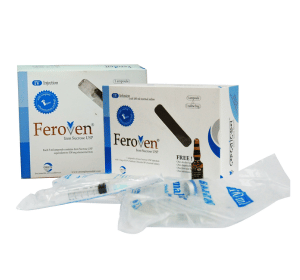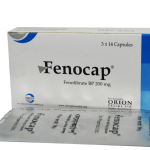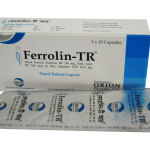Feroven

HAEMATINICS: Iron Sucrose
Indication
Feroven is indicated for the treatment of Iron deficiency in the following indications:
- Where there is a clinical need for a rapid Iron supply
- In patients who cannot tolerate oral Iron therapy or who are non-compliant
- In active inflammatory bowel disease where oral Iron preparations are ineffective
- Non-dialysis dependent-chronic kidney disease (NDD-CKD) patients receiving an erythropoietin
- Non-dialysis dependent-chronic kidney disease (NDD-CKD) patients not receiving an erythropoietin
- Hemodialysis dependent-chronic kidney disease (HDD-CKD) patients receiving an erythropoietin
- Peritoneal dialysis dependent-chronic kidney disease (PDD-CKD) patients receiving an erythropoietin
It is also indicated in the treatment of Iron deficiency anemia in patients undergoing surgical procedures, patients donating blood & postpartum patients.
Contraindication
The use of Iron Sucrose is contraindicated in patients with evidence of Iron overload, in patients with known hypersensitivity to Iron Sucrose or any of its inactive components and in patients with anemia not caused by Iron deficiency.
Dosage & Administration
Administration: Feroven is exclusively to be administered intravenously by drip infusion, by slow injection or directly into the venous limb of the dialyser and is not suitable for intramuscular use and for total dose infusion (TDI). Before administration of the first therapeutic dose, a test dose should be given. If any allergic reactions or intolerance occurs during administration, the therapy must be stopped immediately.
Intravenous injection: Feroven can also be administered undiluted by slow intravenous injection at the (normal) recommended rate of 1 ml Feroven (20 mg Iron) per minute [5 ml Feroven (100 mg Iron) in 2 to 5 minutes]. A maximum of 10 ml Feroven (200 mg Iron) can be injected per injection. Before administration of the therapeutic dose in a new patient a test dose of 1 ml Feroven (20 mg Iron) in adults and in children with a body weight greater than 14 kg and half the daily dose (1.5 mg Iron/kg) in children with a body weight less than 14 kg should be injected over 1 to 2 minutes. If no adverse reactions occur within a waiting period of 15 minutes, the remaining portion of the injection can be administered at recommended speed. After an injection the arm of the patient should be extended.
Infusion: Feroven should preferably be administered by drip infusion (in order to reduce the risk of hypotensive episodes and paravenous injection) in a dilution of 1 ml Feroven (20 mg Iron) in max. 20 ml 0.9% w/v Sodium Chloride [5 ml (100 mg Iron) in max. 100 ml 0.9% w/v NaCl e.t.c. up to 25 ml (500 mg Iron) in max. 500 ml 0.9% w/v NaCI]. Dilution must take place immediately prior to infusion and the solution should be administered as follows: 100 mg Iron in at least 15 minutes; 200 mg Iron in at least 30 minutes; 300 mg Iron in at least 1.5 hours; 400 mg Iron in at least 2.5 hours and 500 mg Iron in at least 3.5 hours. For the administration of the maximum tolerated single dose of 7 mg Iron/kg body weight, an infusion time of at least 3.5 hours has to be maintained, independently of the total dose.
Before administration of the therapeutic dose in a new patient, the first 20 mg Iron in adults and in children with a body weight greater than 14 kg and half the daily dose (1.5 mg Iron/kg) in children with a body weight less than 14 kg should be infused over 15 minutes as a test dose. If no adverse reactions occur, the remaining portion of the infusion can be administered at recommended speed.
Injection into dialyser: Feroven may be administered directly into the venous limb of the dialyser under the same conditions as for intravenous injection.
Hemodialysis dependent-chronic kidney disease patients (HDD-CKD): Feroven may be administered undiluted as a 100 mg slow intravenous injection over 2 to 5 minutes or as an infusion of 100 mg, diluted in a maximum of 100 ml of 0.9% NaCl over a period of at least 15 minutes per consecutive hemodialysis session for a total cumulative dose of 1,000 mg.
Non-dialysis dependent-chronic kidney disease patients (NDD-CKD): Feroven is administered as a total cumulative dose of 1,000 mg over a 14 day period as a 200 mg slow IV injection undiluted over 2 to 5 minutes on 5 different occasions within the 14 day period.
Peritoneal dialysis dependent-chronic kidney disease patients (PDD-CKD): Feroven is administered as a total cumulative dose of 1,000 mg in 3 divided doses, given by slow intravenous infusion, within a 28 day period: 2 infusions of 300 mg over 1.5 hours 14 days apart followed by one 400 mg infusion over 2.5 hours 14 days later. The Feroven dose should be diluted in a maximum of 250 ml of 0.9% NaCl.
Note: Do not mix Iron Sucrose with other medications or add to parenteral nutrition solutions for intravenous infusion. Parenteral drug products should be inspected visually for particulate matter and discoloration prior to administration, whenever the solution and container permit.
Side Effect
Adverse reactions, whether or not related to Iron Sucrose administration, reported are as follows: Hypotension, cramps/leg cramps, nausea, headache, vomiting and diarrhea. Some of these symptoms may be seen in patients with chronic renal failure or on hemodialysis not receiving intravenous Iron. In safety studies, several patients experienced mild or moderate hypersensitivity reactions presenting with wheezing, dyspnea, hypotension, rashes or pruritus.
Drug Interaction
Iron Sucrose injection should not be administered concomitantly with oral Iron preparations since the absorption of oral Iron is reduced. Even oral Iron therapy should not be given until 5 days after last injection.
Presentation
Feroven Injection: Each commercial box contains one amber ampoule containing 5 ml Iron Sucrose USP with an alcohol pad, a 5 ml disposable syringe and a first aid band.
Feroven Infusion: Each commercial box contains one amber ampoule containing 5 ml Iron Sucrose USP, one saline bag containing 100 ml 0.9% Sodium Chloride BP, an alcohol pad, a 5 ml disposable syringe, a first aid band and a saline set.



